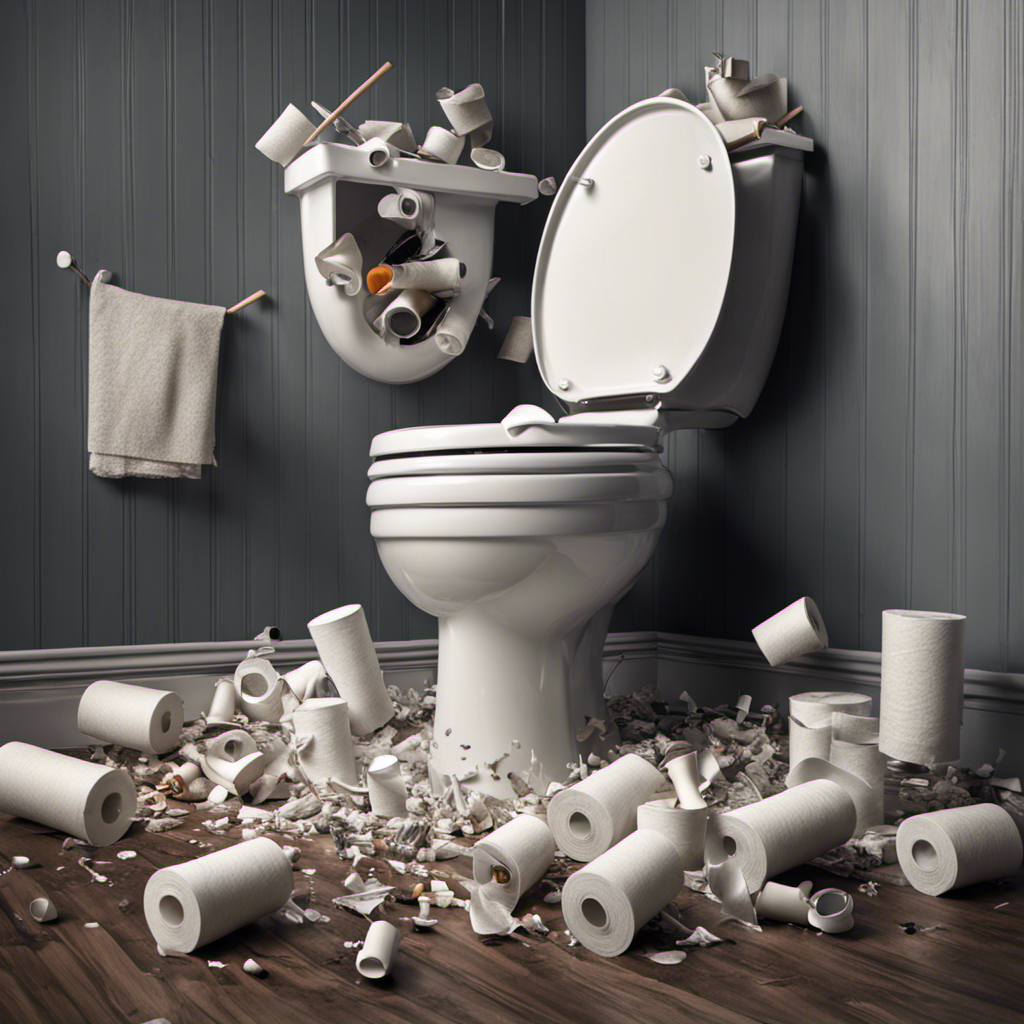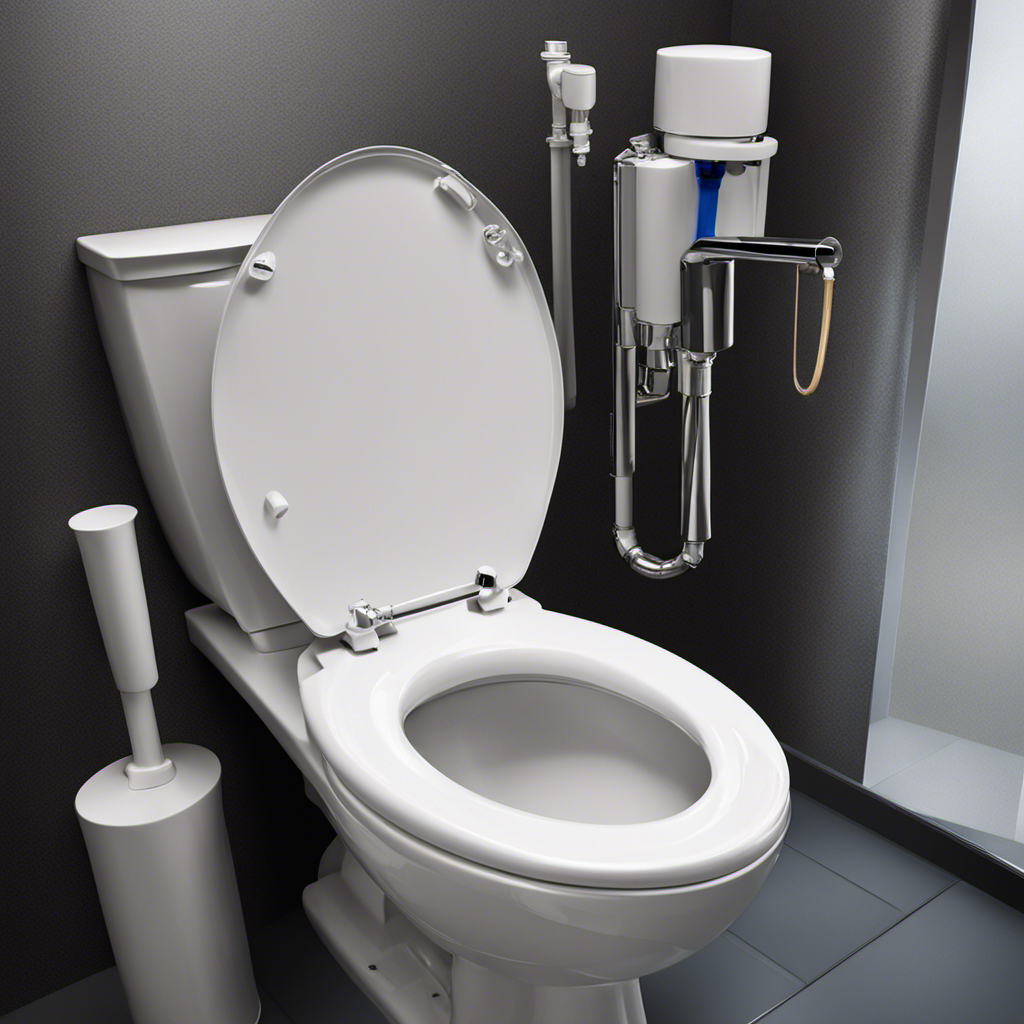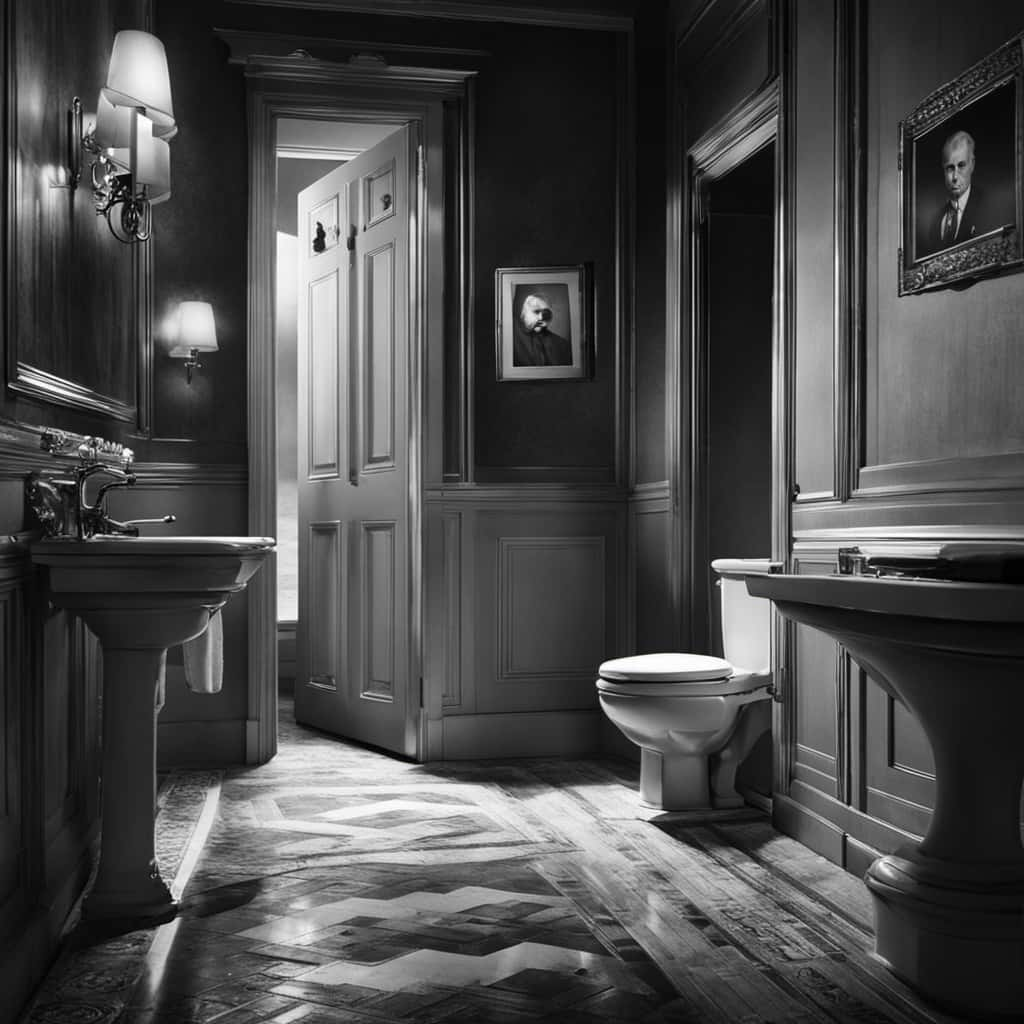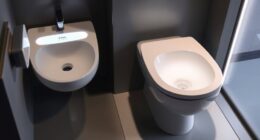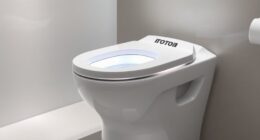Have you ever found yourself frustrated by a stubborn toilet that refuses to flush? Well, fear not, because I’m here to shed some light on this common plumbing predicament.
Picture this: you’re standing in front of your porcelain throne, pressing down on that trusty flush handle, only to be met with disappointment as the water stubbornly remains in the bowl.
In this article, I’ll dive into the various reasons behind why your toilet won’t flush and provide you with the know-how to tackle these issues head-on.
Key Takeaways
- Flapper valve issues can cause stains and weak flush power, so adjusting the chain and replacing the flapper if necessary is important.
- Clogged toilet drains can be resolved using a plunger or toilet auger, with the plunger being the first option and the auger for stubborn clogs.
- Regular inspection and cleaning of the flapper valve is recommended, including checking for damage or wear and adjusting the chain length.
- Low water level in the tank can be fixed by adjusting the float valve, checking for obstructions in the fill tube, and cleaning the fill valve. Faulty parts may need to be replaced.
Common Toilet Flushing Issues
One common issue with toilets not flushing is when the flapper doesn’t close all the way. This can lead to various problems, such as toilet bowl stains and weak flush power.
The flapper is a rubber valve located at the bottom of the toilet tank, which opens to release water into the bowl during a flush and should close tightly afterwards. If it doesn’t, water will continuously leak from the tank into the bowl, causing stains and reducing the amount of water available for a proper flush.
To fix this issue, you can adjust the chain connecting the flapper to the flush handle, ensuring that it is neither too loose nor too tight. If that doesn’t solve the problem, you may need to replace the flapper altogether.
Now, let’s move on to another common issue that can prevent a toilet from flushing properly: a clogged toilet drain.
Clogged Toilet Drain
The clogged drain is preventing my toilet from working properly.
When faced with a clogged toilet drain, there are a couple of tools that can come in handy – the toilet plunger and the toilet auger.
The toilet plunger is the first line of defense when it comes to clearing a clog. It uses suction and pressure to dislodge the blockage and restore proper flow.
However, if the plunger doesn’t do the trick, a toilet auger might be necessary. A toilet auger is a flexible tool designed specifically for toilet clogs. It has a long, snaking cable that can reach deeper into the drain to break up and remove stubborn clogs.
Faulty Flapper Valve
When a faulty flapper valve is present, it can cause problems with the proper functioning of the toilet. The flapper valve is a crucial component that controls the flow of water from the tank into the bowl during a flush. If it is not working correctly, it can lead to issues such as water leakage, incomplete flushes, or even a continuously running toilet. To maintain the flapper valve, regular inspection and cleaning are recommended. Troubleshooting a faulty flapper valve involves checking for any visible signs of damage or wear, ensuring proper alignment, and adjusting the chain length if necessary. If these steps do not resolve the issue, it may be necessary to replace the flapper valve altogether. By keeping up with flapper valve maintenance and addressing any issues promptly, you can ensure that your toilet functions properly and avoids any unnecessary water waste.
| Flapper Valve Maintenance | Troubleshooting Flapper Valve |
|---|---|
| Regular inspection | Check for signs of damage |
| Cleaning | Ensure proper alignment |
| Adjust chain length if needed | |
| Consider valve replacement |
Low Water Level in the Tank
To address the issue of low water level in your tank, you can try adjusting the float valve or checking for any obstructions in the fill tube. These are common toilet maintenance tips that can help troubleshoot toilet problems.
Here are four steps you can take to fix the low water level issue:
-
Adjust the float valve: Locate the float valve inside the tank and adjust it to ensure that it allows enough water to enter the tank during each flush.
-
Check for obstructions in the fill tube: Remove the tank lid and inspect the fill tube for any debris or obstructions that might be preventing water from filling up the tank properly.
-
Clean the fill valve: If the fill valve is dirty or clogged, it may not allow water to enter the tank adequately. Clean the valve using a brush or a cloth to remove any buildup.
-
Replace faulty parts: If adjusting the float valve and cleaning the fill valve doesn’t solve the low water level issue, consider replacing these components with new ones to ensure proper functioning.
Malfunctioning Flush Handle
When it comes to a malfunctioning flush handle, there are two common issues that can arise: a loose flush handle or a broken flush mechanism.
A loose flush handle can be easily fixed by tightening the screws or replacing any worn-out parts.
On the other hand, a broken flush mechanism may require more extensive repairs or even a complete replacement to ensure proper flushing functionality.
It’s important to address these issues promptly to avoid any further inconvenience or potential damage to your toilet.
Loose Flush Handle
Make sure you tighten the flush handle on your toilet to avoid any flushing problems. A loose flush handle can cause difficulties in flushing properly and may even lead to a complete malfunction. Here are four key points to consider when dealing with a loose flush handle:
-
Identify the problem: Check if the handle is loose by gently wiggling it. If it moves easily or feels wobbly, it needs to be tightened or replaced.
-
Tighten the handle: Use a screwdriver or an adjustable wrench to tighten the nut holding the handle in place. Make sure not to overtighten, as it may cause damage.
-
Replace the handle: If tightening doesn’t solve the issue, it may be necessary to replace the entire handle. You can find replacement handles at hardware stores or online.
-
Regular maintenance: To prevent future problems, periodically check the tightness of the handle and tighten if necessary.
Ensuring a secure flush handle will help maintain the proper functioning of your toilet. However, if the flush handle is not the culprit, the problem may lie with a broken flush mechanism.
Broken Flush Mechanism
Now that we have addressed the issue of a loose flush handle, let’s move on to the next possible culprit for a malfunctioning toilet flush: a broken flush mechanism.
When the flush mechanism is broken, it can prevent the proper flow of water from the tank into the bowl, resulting in a weak or non-existent flush.
To troubleshoot this problem, you will need to remove the tank lid and inspect the flush mechanism. Look for any signs of damage or wear, such as broken or disconnected parts. If you notice any issues, it may be necessary to replace the flush mechanism.
Toilet flush repair can be done by purchasing a replacement flush mechanism kit from a hardware store and following the instructions provided. If you are unsure about the process, it is recommended to seek the assistance of a professional plumber to ensure a proper and effective repair.
Blocked Vent Pipe
If the toilet won’t flush, it could be because there’s a blockage in the vent pipe. The vent pipe is an important component of the plumbing system as it allows air to enter and exit the drainage system, ensuring proper flow and preventing pressure buildup. When the vent pipe gets blocked, it disrupts the air balance, causing water to drain slowly or not at all.
To address this issue, here are four things to consider:
-
Regular ventilation system maintenance: Inspecting and cleaning the vent pipe regularly can help prevent blockages caused by debris, leaves, or bird nests.
-
Proper plumbing installation: Ensuring that the vent pipe is properly installed during construction or renovation is crucial to avoid future blockages.
-
Professional assistance: If you suspect a blockage in the vent pipe, it’s best to seek the help of a licensed plumber who can diagnose and resolve the issue effectively.
-
Prevention is key: Avoid flushing non-flushable items like wipes, tissues, or feminine hygiene products as they can contribute to vent pipe blockages over time.
Frequently Asked Questions
How Do I Fix a Leaking Toilet?
To fix a leaking toilet, start by checking the toilet tank for any cracks or loose fittings. If everything looks fine, the issue might be with the water pressure. Adjust the water pressure to stop the leak.
What Causes a Toilet to Overflow?
Sometimes, toilets can be finicky. There are a few common toilet flushing problems that can lead to an overflow. Understanding toilet clog prevention techniques can help keep your bathroom running smoothly.
Why Is My Toilet Making a Gurgling Sound?
When a toilet makes a gurgling sound, it could be due to various causes such as a clogged vent pipe or a malfunctioning fill valve. To stop toilet gurgling, it’s best to consult a plumber for proper diagnosis and repair.
Can a Clogged Vent Pipe Affect the Toilet’s Flushing Ability?
Yes, a clogged vent pipe can indeed affect the flushing ability of a toilet. Signs of a blocked vent pipe include gurgling sounds and slow drains. Resolving this issue requires professional help to clear the obstruction.
How Do I Replace a Faulty Flapper Valve in My Toilet?
To replace a faulty flapper valve in my toilet, first, turn off the water supply to the toilet tank. Then, remove the old flapper by disconnecting the chain and attaching the new flapper in its place. Finally, turn the water supply back on.
Conclusion
So, if you ever find yourself in the frustrating situation of a toilet that won’t flush, fear not! There are several common issues that may be causing the problem.
From a clogged toilet drain to a faulty flapper valve, there are various potential culprits to consider. However, one interesting statistic to keep in mind is that approximately 90% of toilet flushing issues are due to a clogged toilet drain. This emphasizes the importance of proper maintenance and avoiding flushing inappropriate items down the toilet.
By understanding these common issues, you can quickly troubleshoot and resolve your toilet flushing problems.
